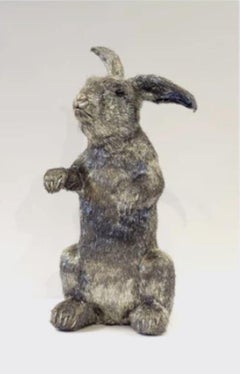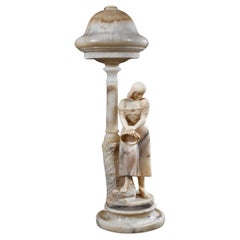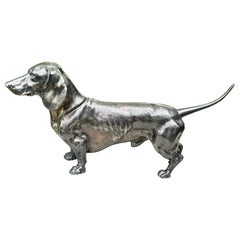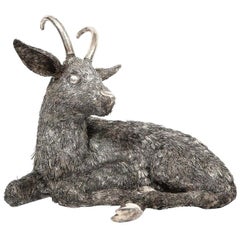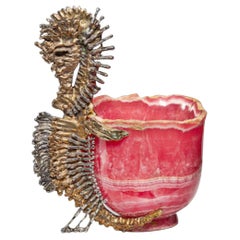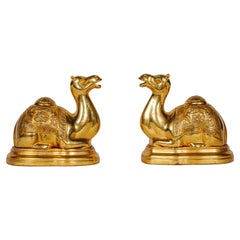New York City - Figurines and Sculptures
to
25
34
29
24
8
8
12
7
6
6
5
3
24
58
8
1
1
1
1
2
1
1
87
6
8
8
6
4
2
12
2
2
2
1
6
6
2
1
1
1
93
93
234
116
Item Ships From: New York City
Mario Buccellati Life Size Silver Rabbit
By Mario Buccellati
Located in New York, NY
Mario Buccellati life size silver rabbit. A life-Size silver rabbit crafted with a technique know as ‘lavorazione a pelo’ or ‘hair-like workmanship. This technique involved infinite ...
Category
1970s Italian Vintage New York City - Figurines and Sculptures
Materials
Silver
Important Rare Large Museum Quality 19th C Alabaster Young Woman with Jug Lamp
Located in New York, NY
The Following Item we are offering is An Outstanding Rare Important Fine Impressive 19th Century Estate Marble and Alabaster Figure of a Beautiful Gorgeous Young Woman Holding a Wate...
Category
19th Century Antique New York City - Figurines and Sculptures
$2,500 Sale Price
72% Off
WMF Silverplate Dachshund Dog Figure Monumental 14 Inch Rare Circa 1880
By WMF Württembergische Metallwarenfabrik
Located in New York, NY
THIS IS A SUPERB ANTIQUE WMF SILVER PLATE DACHSHUND DOG FIGURE IN A MONUMENTAL SIZE OF 14 INCHES LONG AND 7 INCHES TALL AND 3.5 INCHES DEEP, AND DATING TO CIRCA 1900. THE DACHSHUND IS A MUSEUM QUALITY PIECE AND IS EXTREMELY RARE. IT IS MADE BY THE ESTEEMED GERMAN COMPANY WMF. THE EXPRESSION ON THE FACE IS EXTRAORDINARY. THE MODELING IS MAGNIFICENT. THIS IS ONE OF THE FINEST QUALITY ANTIQUE DOG FIGURES...
Category
Early 20th Century German Art Nouveau New York City - Figurines and Sculptures
Materials
Silver Plate
Mario Buccellati, a Rare and Exceptional Italian Silver Goat
By Mario Buccellati
Located in Queens, NY
Mario Buccellati, A Rare and Exceptional Italian Silver Goat circa 1940.
Made in Milan Italy.
Very fine quality and workmanship and very large in size.
Measures: 12" high x 14" w...
Category
20th Century Italian New York City - Figurines and Sculptures
Materials
Silver
Chaumet Paris, a French Silver-Gilt Seahorse Mounted Rhodochrosite Cup
By Chaumet
Located in Queens, NY
Chaumet Paris, A French Silver-Gilt Seahorse Mounted Rhodochrosite cup
Circa 1980.
An exceptional object
A quadrangular cut cup in rhodochrosite and the handle made of a seahorse ...
Category
20th Century French New York City - Figurines and Sculptures
Materials
Rhodocrosite, Silver
$14,000 Sale Price
60% Off
A Pair of Opulent Sterling Silver-Gilt Camel Incense Burners, circa 1900
Located in Queens, NY
A Pair of Opulent Sterling Silver-Gilt 925 Camel Incense Burners on Giltwood Stands, Circa 1900
Masterfully crafted, these pieces epitomize the grandeur and sophistication of the pe...
Category
Late 19th Century Antique New York City - Figurines and Sculptures
Materials
Sterling Silver
Chinese Hand-Carved Coral Sculpture Guanyin and Dragon
Located in New York, NY
Chinese Gwandian carved coral sculpture Guanyin and Dragon
Very finely hand-carved.
Circa Late 20th century, China
Weight:
With stand: 360.6 grams
Without stand: 280.7 grams
Dime...
Category
Late 20th Century Chinese New York City - Figurines and Sculptures
Materials
Coral
Mario Buccellati Life Size Silver Yorkshirre Terrier Dog
By Mario Buccellati
Located in New York, NY
Mario Buccellati Life Size Silver Yorkshirre Terrier Dog.
A life-size silver dog crafted with a technique know as ‘lavorazione a pelo’ or ‘hair-like workmanship. This technique invo...
Category
1970s Italian Vintage New York City - Figurines and Sculptures
Materials
Silver
Chinese Hand-Carved Coral Dragon Figure
Located in New York, NY
Chinese carved coral dragon figure
Very finely hand-carved.
Circa 20th Century, China
Weight: With Stand approximately 345.1,
Without Stand appr...
Category
20th Century Chinese New York City - Figurines and Sculptures
Materials
Coral
Ancient Roman Military Bronze Stag And Eagle 1st-2nd century AD Guarantee Rare
Located in New York, NY
This Ancient Roman Military Bronze eagle and stag, dating from the 1st to 2nd century AD, stands at a modest yet captivating 3 1/8 inches in height. The finely cast bronze sculpture ...
Category
15th Century and Earlier Italian Classical Roman Antique New York City - Figurines and Sculptures
Materials
Bronze
Antique Large Bronze Roundel of Hercules Fighting Centaur
Located in New York, NY
Large bronze roundel with mythological scene depicting Hercules fighting a centaur. France, circa 19th century.
Category
19th Century French Antique New York City - Figurines and Sculptures
Materials
Bronze
German Shepherd Dog Austrian Vienna Bronze Circa 1900 6.5 Inch Austria Bronze
Located in New York, NY
THIS IS A SUPERB ANTIQUE AUSTRIAN VIENNA BRONZE OF A LARGE GERMAN SHEPHERD DOG. THE WONDERFUL MODELING AND PAINTING OF THIS LARGE 6 1/2 INCH LONG DOG IS OF THE FINEST QUALITY.
This ...
Category
Early 20th Century Austrian Gilded Age New York City - Figurines and Sculptures
Materials
Bronze
Poodle Dog Austrian Vienna Bronze Circa 1900 Miniature Cold Painted Bronze
Located in New York, NY
THIS IS A SUPERB ANTIQUE AUSTRIAN VIENNA BRONZE OF A BLACK POODLE DOG.
This wonderful antique Austrian Vienna Bronze (Bronze de Vienne, Wiener Bronze, Cold Painted Bronze) dates to ...
Category
Early 20th Century Austrian Gilded Age New York City - Figurines and Sculptures
Materials
Bronze
Monkey Band Austrian Vienna Bronze 9 Piece Antique circa 1900 Drum Violin Horn
Located in New York, NY
THIS IS A RARE MONKEY BAND WITH NINE PLAYERS AND CONDUCTORS. THE MONKEY MUSICIANS ARE ANTIQUE AUSTRIAN VIENNA BRONZES. THE BAND INCLUDES THE CONDUCTOR WITH MUSIC STAND, DRUM, VIOLIN, TRUMPET, CELLO OR BASE, CYMBALS, FRENCH HORN OR TUBA AND FLUTE.
These wonderful antique Austrian Vienna Bronzes (Bronze de Vienne...
Category
Early 20th Century Austrian Victorian New York City - Figurines and Sculptures
Materials
Bronze
Cat Kitten On Bell Telephone Austrian Vienna Bronze circa 1900 Miniature Bronze
Located in New York, NY
THIS IS A SUPERB CHARMING ANTIQUE AUSTRIAN VIENNA BRONZE OF A CAT OR KITTEN LISTENING ON TWO BELL TELEPHONES.
This wonderful antique Austrian Vienna Bronze (Bronze de Vienne...
Category
Early 20th Century Austrian Gilded Age New York City - Figurines and Sculptures
Materials
Bronze
Set of 5 Antique German Jeweled Silver and Shell Country Folk Figures
Located in New York, NY
Five German 812 silver figures, ca 1880. This set comprises two musicians, a tankard-bearing tavern keeper, a fowl-serving wench, and a dagger-wielding pierrot let loose among these ...
Category
Late 19th Century German Victorian Antique New York City - Figurines and Sculptures
Materials
Multi-gemstone, Silver
Rare 19th Century Antique Russian Bronze of a Boy Horse Group Evgeni Lanceray
Located in New York, NY
A Beautiful and Rare Original 19th Century Russian Bronze Sculpture by Evgeni Lanceray, Cast bronze figural group. Bronze Showcases a young bo...
Category
19th Century Antique New York City - Figurines and Sculptures
Materials
Bronze
$3,000 Sale Price
80% Off
Three Little Pigs Piglets Austrian Vienna Bronze circa 1900 Geschutzt Pig
Located in New York, NY
THIS IS A SUPERB SET OF THREE LITTLE PIGS BRONZES. THE PIGS ARE ANTIQUE AUSTRIAN VIENNA BRONZES.
These wonderful antique Austrian Vienna Bronzes (Bronze de Vienne, Wiener Bronze, Cold Painted Bronze) date to circa 1900. The bronzes are of the highest quality of Vienna Bronzes with superb modeling and expression. They are cold painted with beautiful details. The bronzes are very possibly made by Bergmann. They are marked GESCHUTZT, the German mark for imports.
The three pig...
Category
Early 20th Century Austrian Gilded Age New York City - Figurines and Sculptures
Materials
Bronze
$1,250 Sale Price / set
21% Off
19th Century Antique Museum Quality Henri Louis Levasseur Female Bronze Maiden
Located in New York, NY
The Following Item is An Outstanding 19th Century Bronze sculpture showcasing a Standing female showcasing a Beautiful Bronze Woman with one arm raised and one the other hand holding...
Category
Late 19th Century Antique New York City - Figurines and Sculptures
Materials
Bronze
$7,200 Sale Price
60% Off
Poodle Dog Holding Purse Austrian Vienna Bronze Circa 1900 Miniature Bronze
Located in New York, NY
THIS IS A SUPERB AUSTRIAN VIENNA BRONZE OF A WHITE POODLE DOG CARRYING A PURSE.
This wonderful antique Austrian Vienna Bronze (Bronze de Vienne, Wiener Bron...
Category
Early 20th Century Austrian Gilded Age New York City - Figurines and Sculptures
Materials
Bronze
Beautiful Original 19th Century Italian Marble Sculpture Lamp Ferdinando Vichi
Located in New York, NY
The Following Item is a Museum Quality Original Beautiful Italian White Marble and Alabaster Lamp Sculpture of a Figural Nude Woman Sitting on a Rock by Artist Ferdinando Vichi (1875...
Category
19th Century Antique New York City - Figurines and Sculptures
$4,750 Sale Price
50% Off
Alex Soldier Essence of Woman Sculpture One of a Kind
By Alex Soldier
Located in New York, NY
Alex Soldier created a conceptual work of art titled Essence Of A Woman to celebrate women around the world in all of their incredibly versatile nature, character and beauty. The sta...
Category
2010s American Contemporary New York City - Figurines and Sculptures
Materials
Crystal, Onyx, Platinum, Rhodium, Silver, Sterling Silver
Rare Pair of Important New York Estate English Silver White Jade Candlesticks
Located in New York, NY
The Following Item we are Offering is a Lovely Museum Quality Large and very elaborately openwork carved in an Exceptional even White Stone. Beautifully carved as a standing figure o...
Category
20th Century New York City - Figurines and Sculptures
Materials
Jade, Silver
$500 Sale Price
72% Off
Gorgeous Rare Pair Maitland Smith Bronze Mother of Pearl Life Size Parrot Birds
Located in New York, NY
The Following Items we are offering are a Rare Pair of Large Original Maitland Smith Impressive Cast Bronze and Patinated Parrots resting on Tree Stumps, their wing and tail feathers...
Category
20th Century New York City - Figurines and Sculptures
Materials
Bronze
$2,400 Sale Price
60% Off
Rare Important Bronze Estate Gladenbeck Bronze Boy on Marble Sculpture
Located in New York, NY
An Exquisite and Beautiful Museum Quality Estate Bronze boy holding monkey. The Bronze with a mid brown patina, depicting the young boy with the monkey hanging from his shirt, on cir...
Category
19th Century Antique New York City - Figurines and Sculptures
Materials
Bronze
Chinese Hand-Carved Coral Figure
Located in New York, NY
Chinese carved coral figure of a woman's face
Very finely hand-carved.
Late 20th Century, China
Weight: 182 grams with base
Dimensions: approximately...
Category
Late 20th Century Chinese New York City - Figurines and Sculptures
Materials
Coral
Radha Krishna God Aquamarine Figurine
Located in New York, NY
An exceptionally stunning carving of the Hindu Gods Radha & Krishna in a rare Bi-Color Aquamarine with paint work as well. The figurine’s dimensions are 2” ...
Category
2010s New York City - Figurines and Sculptures
Materials
Aquamarine
$10,000 Sale Price
25% Off
Antique Silver Belle with Figural Fowl-Bearing Countryman Handle
Located in New York, NY
Turn-of-the-century European silver bell. Tulip-bowl with twisted gadrooning. Figural handle depicting an old-fashioned countryman holding two live fowl. Here’s dinner—eventually. Su...
Category
Early 20th Century Unknown Edwardian New York City - Figurines and Sculptures
Materials
Silver
Russian Antique Imperial Nephrite Sterling Silver Rat Sculpture
Located in New York, NY
This exquisite Russian Imperial sculpture features a rat in a top hat with a movable cane crafted out of sterling silver and nephrite. The nephrite is medium to medium light muddy gr...
Category
Early 1900s Antique New York City - Figurines and Sculptures
Materials
Sterling Silver
Rare Important Estate Genuine Bone Boat with 7 HAPPY G-ds with Cabochon Stones
Located in New York, NY
The Following Item we are offering is a Large Spectacular Estate Hand Carved Cow Bone with the Seven Happy G-ds Aboard. Taken out of a Private Collecti...
Category
Early 20th Century New York City - Figurines and Sculptures
$1,225 Sale Price
65% Off
Mellerio Paris, French Gold, Diamonds, Silver, Lapis, and Obsidian Polo Player
By Mellerio dits Meller
Located in Queens, NY
Mellerio Paris, A French Gold, Diamonds, Silver-Gilt, Rock Crystal, Enamel, Emerald, Lapis Lazuli, Agate, Emerald, and Obsidian Polo Player, Carved Horse Sculpture, Jeweled Mounted Object.
An extremely rare and unique, one of a kind French Carved Horse Sculpture, Jeweled Mounted Object sculpture "CHEVAUX DE LEGENDE", "A Legendary Horse" by Mellerio, Paris, circa 1999.
Sitting on black obsidian base, the solid rock-crystal slab is finely applied with a carved obdisian hardstone horse and polo player, mounted in 18k gold, brilliant -cut diamonds, emaralds, enamel, lapis lazuli, and agate, .The obsidian base with a plaque engraved: CHEVAUX DE LEGENDE" / MELLERIO DITS MELLER PARIS / 5003 DIV
The piece is in excellent condition and comes with a custom made wood case made for transport. It's very elegant and has French hallmarks throughout. A truly magnificent piece.
Measures 12" high x 8" wide x 4" deep
Founded in France in 1613 by the descendants of Italian immigrants from the Vigezzo Valley in the north of Italy, Mellerio is one of the oldest jewellery houses in Europe. The family business soon attracted the attention of the Royal Court and Marie Antoinette herself reportedly purchased a precious bracelet featuring 7 cameos surrounded by rubies in 1780. Later on, in the 19th century, Mellerio became the official supplier of the French Royal family and the Court of Netherland.
Mellerio creates many jewellery items, all set with rare gems such as peridots, amethysts, aquamarines, citrines and topaz, applying for a patent, the flexible stem, a very supple and light jewellery mechanism. Mellerio remains also well known for their spectacular series of Art Nouveau jewels, created at the beginning of the 20th century, as well as for the creation of trophies rewarding some of the greatest footfall and tennis players of history. In 1993, the jewellery house launched their first watch collection.
Today, Mellerio has stores in Paris, Japan and Hong Kong.
July 14, 1789: this date is known throughout the world as the beginning of the French Revolution. According to a ledger belonging to House of Mellerio, this was also the day that the jeweler sold a golden key to the Comte de Coutance for 10 livres. This ledger, as well as inventories dating as far back as 1768, are the jeweler’s oldest archives. These archives have continued to grow over the years, as the House, established on rue de la Paix in Paris, still lives on today, still in the hands of the same family from Craveggia, in the North of Italy.
The tumultuous history of the Mellerio family in France probably goes as far back as the Italian wars of the Renaissance, but the first official document proving their commercial activity in Paris dates back to 1613. This document is the famous royal warrant awarded by Marie de Medici to a number of Italian families established along the rue des Lombards, including the Mellerios, allowing them to sell “small jewelery items”, therefore granting them a small exception to the traditional monopoly enjoyed by Parisian jewelers. At that time, powerful corporations regulated the operations and customs of Parisian business, but thanks to this exceptional warrant, the Mellerios managed to escape the confines of this framework. Today, this wax-sealed document is kept at the city hall of Craveggia.
From 1613 to the Revolution, the Mellerios lived between France and Italy. The corporations tried many times to put an end to their trade privileges, but all in vain, as a dynasty of sovereigns renewed the warrant. Always marrying and often retiring in Craveggia, the Mellerios continued to maintain their jewelry business in Paris. At first, they did this without a shop. Wearing backpacks (wooden boxes divided into small compartments where jewels were kept), they would tour town fairs around Paris and royal castles.
This is how Jean-Baptiste Mellerio (1765-1850) is said to have sold a bracelet set with rubies and Antique cameos to Marie-Antoinette, which still exists today. Many elements seem to prove the veracity of this anecdote. The queen was particularly fond of cameos, which cover the entire background of her famous jewelry cabinet, and ruby was her favorite stone after diamond. The famous bracelet, reacquired a few years ago by the House of Mellerio, is indeed an 18th century jewel, set with antique cameos representing the profiles of Roman emperors. Two branches of the family were operating in Paris during this time, under the reign of Louis XVI: that of Jean-François (1746-1828), the paternal ancestor of the current Mellerios, and that of Jean-Baptiste (1765-1850).
The French Revolution forced them to return to Italy. However, both Jean-Baptiste and François Mellerio (1772-1843), who was the son of Jean-François, were eventually able to return to Paris after the founding of the Consulate. Jean-Baptiste opened a shop at the Iron Crown of rue Vivienne, and François opened his at the Palais des Tuileries, rue du Coq Saint-Honoré. His well-organized order books give an idea of his high-ranking clientele during the “Old Regime”, among which were the Comte and Comtesse Octave de Segur, the Marquise (later Duchess) de Tourzel, former governess of the royal children, and her daughter, the Comtesse de Bearn, the Craufurds -who organized the flight to Varennes, the Duc and Duchess de Gramont, the Comtesse de Boigne, and Madame de Souza, Talleyrand’s mistress.
We also see the names of the imperial family: Empress Josephine, the Queen of Holland, Princess Elisa, Caroline and Pauline. At that time, the House of Mellerio specialized, among other things, in the trade of antique cameos, a newly fashionable genre of jewel that captured the imagination of all the princesses and noble women of the time.
The years of the Restauration and July Monarchy were among the most glorious. The Bourbons were back on the throne, and the clientele of the House of Mellerio had regained its former wealth. Mellerio supplied Louis-Philippe, Duke of Orléans, as well as his mother, wife and sister, with sumptuous jewels, including a set of emeralds made piece by piece, while the Duke of Bourbon, last prince of the House of Condé, offered diamonds to his mistress, the scheming Baronne de Feucheres, and Monsieur de LaFayette also bought cameos for one of his granddaughters. For the first time, Mellerio ventured into the world of arts in 1815, when Carlotta Grisi, a famous dancer who created Giselle, as well as an actress named Rachel, bought jewels at the Mellerio store on rue de la Paix.
1848 marked a new turning point. France once again became a Republic. François Mellerio handed the company over to his son, Jean, and the latter decided to travel to Spain to build a new clientele. He later became one of the jewelers of the royal family, and met Eugénie de Montijo, who remained a faithful client when she became empress of the French people. The Imperial years were lavish. During the Second Empire, Paris was a pageant of crinoline dresses designed by Worth, while jewels by Mellerio, Worth’s neighbour on the rue de la Paix, adorned the noble women of the Tuileries court.
The Empress bought pearls. Mathilde Bonaparte...
Category
20th Century French Art Deco New York City - Figurines and Sculptures
Materials
Agate, Diamond, Emerald, Rock Crystal, Gold, Silver
Mellerio Paris, a French Gold, Diamonds, Silver, and Smoky Quartz Carved Horse
By Mellerio dits Meller
Located in Queens, NY
Mellerio Paris, A French Gold, Diamonds, Silver-Gilt, Rock-Crystal, Jade, Mother-Of-Pearl and Smoky Quartz, Carved Horse Sculpture, Jeweled Mounted Object.
An extremely rare and unique, one of a kind French gold, diamonds, Silver-gilt, rock-crystal, jade, obsidian, mother-of-pearl, and smoky quartz carved jeweled sculpture "CHEVAUX DE LEGENDE", "A Legendary Horse" by Mellerio, Paris, circa 1991.
Sitting on black obsidian base, the solid rock-crystal slab is finely applied with a carved smoky -quartz and jade horse with a harness mounted in 18k gold, brilliant -cut diamonds, rubies, turquoise, and amethyst chains and pendants. The top columns adorned with 18k gold and brilliant cut diamond pendants, the bottom with gold and mother of pearl plaques. The obsidian base with a plaque engraved: CHEVAUX DE LEGENDE" / N° 05 / MELLERIO DITS MELLER / PARIS / 5003 D
The piece is in excellent condition and comes with a custom made wood case made for transport. It's very elegant and has French hallmarks throughout. A truly magnificent piece.
Measures 10.5" high x 8.5" wide x 4" deep
Founded in France in 1613 by the descendants of Italian immigrants from the Vigezzo Valley in the north of Italy, Mellerio is one of the oldest jewellery houses in Europe. The family business soon attracted the attention of the Royal Court and Marie Antoinette herself reportedly purchased a precious bracelet featuring 7 cameos surrounded by rubies in 1780. Later on, in the 19th century, Mellerio became the official supplier of the French Royal family and the Court of Netherland.
Mellerio creates many jewellery items, all set with rare gems such as peridots, amethysts, aquamarines, citrines and topaz, applying for a patent, the flexible stem, a very supple and light jewellery mechanism. Mellerio remains also well known for their spectacular series of Art Nouveau jewels, created at the beginning of the 20th century, as well as for the creation of trophies rewarding some of the greatest footfall and tennis players of history. In 1993, the jewellery house launched their first watch collection.
Today, Mellerio has stores in Paris, Japan and Hong Kong.
July 14, 1789: this date is known throughout the world as the beginning of the French Revolution. According to a ledger belonging to House of Mellerio, this was also the day that the jeweler sold a golden key to the Comte de Coutance for 10 livres. This ledger, as well as inventories dating as far back as 1768, are the jeweler’s oldest archives. These archives have continued to grow over the years, as the House, established on rue de la Paix in Paris, still lives on today, still in the hands of the same family from Craveggia, in the North of Italy.
The tumultuous history of the Mellerio family in France probably goes as far back as the Italian wars of the Renaissance, but the first official document proving their commercial activity in Paris dates back to 1613. This document is the famous royal warrant awarded by Marie de Medici to a number of Italian families established along the rue des Lombards, including the Mellerios, allowing them to sell “small jewelery items”, therefore granting them a small exception to the traditional monopoly enjoyed by Parisian jewelers. At that time, powerful corporations regulated the operations and customs of Parisian business, but thanks to this exceptional warrant, the Mellerios managed to escape the confines of this framework. Today, this wax-sealed document is kept at the city hall of Craveggia.
From 1613 to the Revolution, the Mellerios lived between France and Italy. The corporations tried many times to put an end to their trade privileges, but all in vain, as a dynasty of sovereigns renewed the warrant. Always marrying and often retiring in Craveggia, the Mellerios continued to maintain their jewelry business in Paris. At first, they did this without a shop. Wearing backpacks (wooden boxes divided into small compartments where jewels were kept), they would tour town fairs around Paris and royal castles.
This is how Jean-Baptiste Mellerio (1765-1850) is said to have sold a bracelet set with rubies and Antique cameos to Marie-Antoinette, which still exists today. Many elements seem to prove the veracity of this anecdote. The queen was particularly fond of cameos, which cover the entire background of her famous jewelry cabinet, and ruby was her favorite stone after diamond. The famous bracelet, reacquired a few years ago by the House of Mellerio, is indeed an 18th century jewel, set with antique cameos representing the profiles of Roman emperors. Two branches of the family were operating in Paris during this time, under the reign of Louis XVI: that of Jean-François (1746-1828), the paternal ancestor of the current Mellerios, and that of Jean-Baptiste (1765-1850).
The French Revolution forced them to return to Italy. However, both Jean-Baptiste and François Mellerio (1772-1843), who was the son of Jean-François, were eventually able to return to Paris after the founding of the Consulate. Jean-Baptiste opened a shop at the Iron Crown of rue Vivienne, and François opened his at the Palais des Tuileries, rue du Coq Saint-Honoré. His well-organized order books give an idea of his high-ranking clientele during the “Old Regime”, among which were the Comte and Comtesse Octave de Segur, the Marquise (later Duchess) de Tourzel, former governess of the royal children, and her daughter, the Comtesse de Bearn, the Craufurds -who organized the flight to Varennes, the Duc and Duchess de Gramont, the Comtesse de Boigne, and Madame de Souza, Talleyrand’s mistress.
We also see the names of the imperial family: Empress Josephine, the Queen of Holland, Princess Elisa, Caroline and Pauline. At that time, the House of Mellerio specialized, among other things, in the trade of antique cameos, a newly fashionable genre of jewel that captured the imagination of all the princesses and noble women of the time.
The years of the Restauration and July Monarchy were among the most glorious. The Bourbons were back on the throne, and the clientele of the House of Mellerio had regained its former wealth. Mellerio supplied Louis-Philippe, Duke of Orléans, as well as his mother, wife and sister, with sumptuous jewels, including a set of emeralds made piece by piece, while the Duke of Bourbon, last prince of the House of Condé, offered diamonds to his mistress, the scheming Baronne de Feucheres, and Monsieur de LaFayette also bought cameos for one of his granddaughters. For the first time, Mellerio ventured into the world of arts in 1815, when Carlotta Grisi, a famous dancer who created Giselle, as well as an actress named Rachel, bought jewels at the Mellerio store on rue de la Paix.
1848 marked a new turning point. France once again became a Republic. François Mellerio handed the company over to his son, Jean, and the latter decided to travel to Spain to build a new clientele. He later became one of the jewelers of the royal family, and met Eugénie de Montijo, who remained a faithful client when she became empress of the French people. The Imperial years were lavish. During the Second Empire, Paris was a pageant of crinoline dresses designed by Worth, while jewels by Mellerio, Worth’s neighbour on the rue de la Paix, adorned the noble women of the Tuileries court.
The Empress bought pearls. Mathilde Bonaparte...
Category
20th Century French New York City - Figurines and Sculptures
Materials
Amethyst, Diamond, Jade, Quartz, Rock Crystal, Ruby, Turquoise, Gold, Si...
Mellerio Paris, a French Gold, Diamond, Silver-Gilt, Rock-Crystal, & Lapis Horse
By Mellerio Paris
Located in Queens, NY
Mellerio Paris, A French Gold, Diamond, Silver-Gilt, Rock-Crystal, Obsidian & Lapis Horse
An extremely rare and unique, one of a kind French gold, diamonds, Silver-gilt rock-crystal, obsidian and lapis lazuli jeweled sculpture "Bucéphale, Chevaux de légende", "Bucephalus, A Legendary Horse" by Mellerio, Paris, circa 1998.
Sitting on black obsidian base, the solid rock crystal slab is finely applied with a lapis lazuli half-horse with harness mounted in 18k gold and brilliant cut diamonds, between two crystal and lapis lazuli columns adorned with gold and diamonds, insert with 7 ruby cabochons and 1 emerald cabochon, the obsidian base with a plaque engraved: CHEVAUX DE LEGENDE / MELLERIO DITS MELLER / PARIS / 5029 DIV
Bucephalus (c355-326 BC) is among the most famous horses in history, and it was said that this he could not be tamed. The young Alexander the Great, of course, tamed him – and went on to ride his beloved equine companion for many years and into many battles.
The piece is in excellent condition and comes with a custom made wood case made for transport. It's very elegant and has French hallmarks throughout. A truly magnificent piece.
Measures 10" high x 9" wide x 4" deep
Founded in France in 1613 by the descendants of Italian immigrants from the Vigezzo Valley in the north of Italy, Mellerio is one of the oldest jewellery houses in Europe. The family business soon attracted the attention of the Royal Court and Marie Antoinette herself reportedly purchased a precious bracelet featuring 7 cameos surrounded by rubies in 1780. Later on, in the 19th century, Mellerio became the official supplier of the French Royal family and the Court of Netherland.
Mellerio creates many jewellery items, all set with rare gems such as peridots, amethysts, aquamarines, citrines and topaz, applying for a patent, the flexible stem, a very supple and light jewellery mechanism. Mellerio remains also well known for their spectacular series of Art Nouveau jewels, created at the beginning of the 20th century, as well as for the creation of trophies rewarding some of the greatest footfall and tennis players of history. In 1993, the jewellery house launched their first watch collection.
Today, Mellerio has stores in Paris, Japan and Hong Kong.
July 14, 1789: this date is known throughout the world as the beginning of the French Revolution. According to a ledger belonging to House of Mellerio, this was also the day that the jeweler sold a golden key to the Comte de Coutance for 10 livres. This ledger, as well as inventories dating as far back as 1768, are the jeweler’s oldest archives. These archives have continued to grow over the years, as the House, established on rue de la Paix in Paris, still lives on today, still in the hands of the same family from Craveggia, in the North of Italy.
The tumultuous history of the Mellerio family in France probably goes as far back as the Italian wars of the Renaissance, but the first official document proving their commercial activity in Paris dates back to 1613. This document is the famous royal warrant awarded by Marie de Medici to a number of Italian families established along the rue des Lombards, including the Mellerios, allowing them to sell “small jewelery items”, therefore granting them a small exception to the traditional monopoly enjoyed by Parisian jewelers. At that time, powerful corporations regulated the operations and customs of Parisian business, but thanks to this exceptional warrant, the Mellerios managed to escape the confines of this framework. Today, this wax-sealed document is kept at the city hall of Craveggia.
From 1613 to the Revolution, the Mellerios lived between France and Italy. The corporations tried many times to put an end to their trade privileges, but all in vain, as a dynasty of sovereigns renewed the warrant. Always marrying and often retiring in Craveggia, the Mellerios continued to maintain their jewelry business in Paris. At first, they did this without a shop. Wearing backpacks (wooden boxes divided into small compartments where jewels were kept), they would tour town fairs around Paris and royal castles.
This is how Jean-Baptiste Mellerio (1765-1850) is said to have sold a bracelet set with rubies and Antique cameos to Marie-Antoinette, which still exists today. Many elements seem to prove the veracity of this anecdote. The queen was particularly fond of cameos, which cover the entire background of her famous jewelry cabinet, and ruby was her favorite stone after diamond. The famous bracelet, reacquired a few years ago by the House of Mellerio, is indeed an 18th century jewel, set with antique cameos representing the profiles of Roman emperors. Two branches of the family were operating in Paris during this time, under the reign of Louis XVI: that of Jean-François (1746-1828), the paternal ancestor of the current Mellerios, and that of Jean-Baptiste (1765-1850).
The French Revolution forced them to return to Italy. However, both Jean-Baptiste and François Mellerio (1772-1843), who was the son of Jean-François, were eventually able to return to Paris after the founding of the Consulate. Jean-Baptiste opened a shop at the Iron Crown of rue Vivienne, and François opened his at the Palais des Tuileries, rue du Coq Saint-Honoré. His well-organized order books give an idea of his high-ranking clientele during the “Old Regime”, among which were the Comte and Comtesse Octave de Segur, the Marquise (later Duchess) de Tourzel, former governess of the royal children, and her daughter, the Comtesse de Bearn, the Craufurds -who organized the flight to Varennes, the Duc and Duchess de Gramont, the Comtesse de Boigne, and Madame de Souza, Talleyrand’s mistress.
We also see the names of the imperial family: Empress Josephine, the Queen of Holland, Princess Elisa, Caroline and Pauline. At that time, the House of Mellerio specialized, among other things, in the trade of antique cameos, a newly fashionable genre of jewel that captured the imagination of all the princesses and noble women of the time.
The years of the Restauration and July Monarchy were among the most glorious. The Bourbons were back on the throne, and the clientele of the House of Mellerio had regained its former wealth. Mellerio supplied Louis-Philippe, Duke of Orléans, as well as his mother, wife and sister, with sumptuous jewels, including a set of emeralds made piece by piece, while the Duke of Bourbon, last prince of the House of Condé, offered diamonds to his mistress, the scheming Baronne de Feucheres, and Monsieur de LaFayette also bought cameos for one of his granddaughters. For the first time, Mellerio ventured into the world of arts in 1815, when Carlotta Grisi, a famous dancer who created Giselle, as well as an actress named Rachel, bought jewels at the Mellerio store on rue de la Paix.
1848 marked a new turning point. France once again became a Republic. François Mellerio handed the company over to his son, Jean, and the latter decided to travel to Spain to build a new clientele. He later became one of the jewelers of the royal family, and met Eugénie de Montijo, who remained a faithful client when she became empress of the French people. The Imperial years were lavish. During the Second Empire, Paris was a pageant of crinoline dresses designed by Worth, while jewels by Mellerio, Worth’s neighbour on the rue de la Paix, adorned the noble women of the Tuileries court.
The Empress bought pearls. Mathilde Bonaparte...
Category
21st Century and Contemporary French New York City - Figurines and Sculptures
Materials
Diamond, Lapis Lazuli, Rock Crystal, Gold, Silver
Recently Viewed
View AllMore Ways To Browse
Alexandrite Brooch
Angel Skin Quartz
Angela Cummings Tiffanys Pearl Necklace
Antique Chaumet
Antique Cinnabar Jewelry
Antique Circlet
Antique Hera Cameo
Antique Pheasant Brooch
Antique Russian Amber Jewelry
Antique Scottish Thistle Jewelry
Antique Victorian Lava Brooch
Aphrodite Cameo
Baguette Ap
Bijoux Yves Saint Laurent
Blue Sapphire Parure
Bottega Veneta 18k
Boucheron Bird Brooch
Broken English Jewelry
